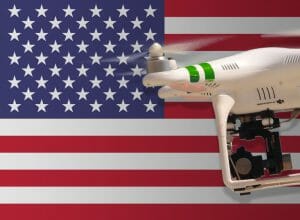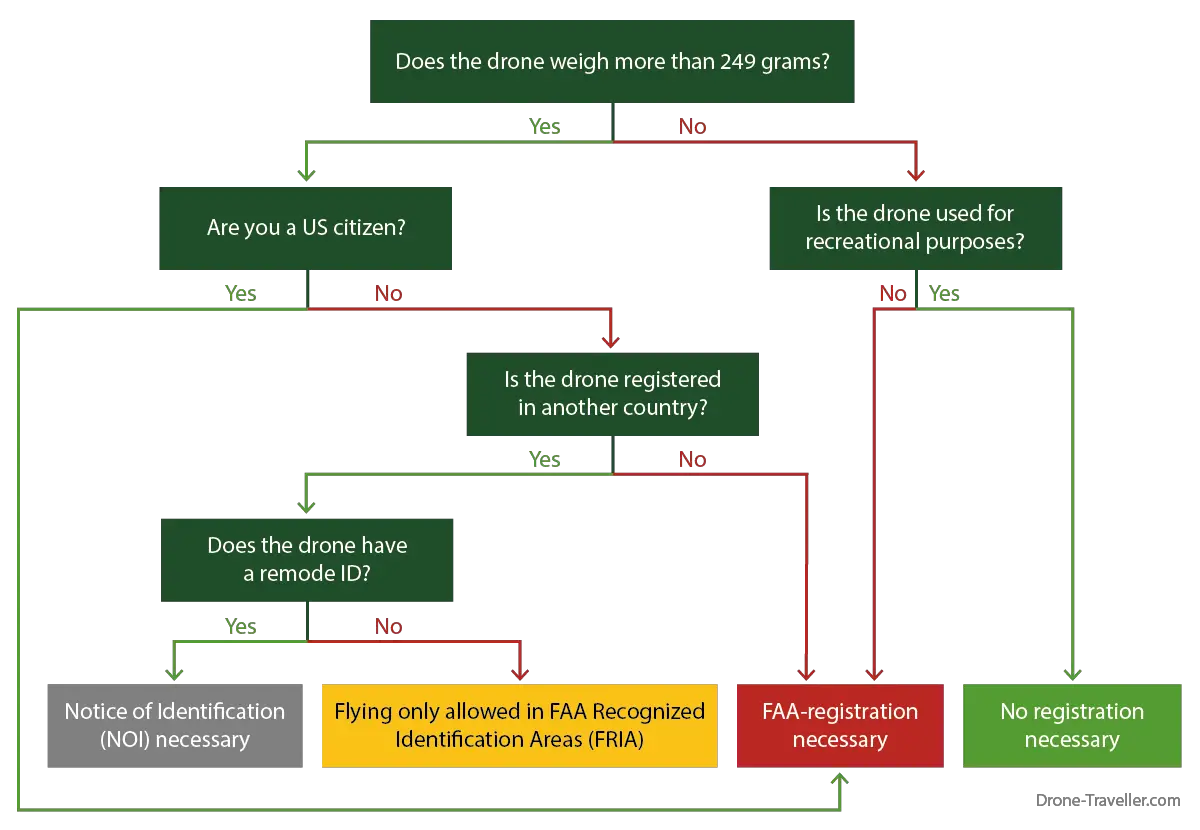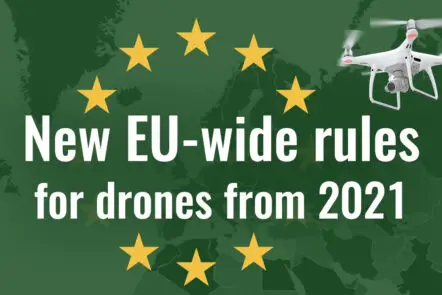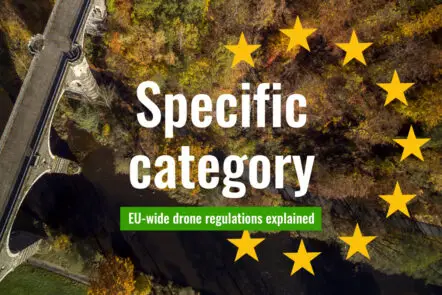Drone Laws in the United States of America (USA)
Last update on 15.04.2024 | 6 Kommentare

In this article, you’ll learn what you need to know about flying a drone in the USA.
Since May 2019, new rules have been in force, which apply to recreational flyers. It took some years until everything was implemented and there still are updates now and again. That’s why it’s advisable to check for updates on the websites of the Federal Aviation Authority (FAA).
Before you can fly in the US, you need to register your copter with the Federal Aviation Authority (FAA). This applies to drones between 250 grams and 25 kilograms. This means private users currently do not have to register their DJI Mavic Mini.
The registration requirement applies to both private and commercial drone users. However, commercial pilots must pay a $5 processing fee.
After completing the registration, you will receive a number for your drone that you need to attach to your aircraft.

New rules for recreational flyers
After months of preparation, “The Recreational Unmanned Aircraft Systems Safety Test” (TRUST) was introduced at the end of June 2021, a knowledge test for recreational pilots. You have to prove general knowledge of the drone rules and safety precautions. The test is free of charge and can be taken online at one of the official test sites. These are listed on the FAA website. The required basic knowledge is given first, followed by the multiple-choice test questions (which are quite easy for experienced drone pilots). If you get a question wrong, you can immediately choose a new answer. After passing, you will receive an electronic certificate with your name and an authentication number to download, which is valid indefinitely. You should always have this certificate with you along with your registration and be able to show it on request. If caught without a TRUST certificate, the fine, if requested, can be around $1,500. Note that without the test you are theoretically not considered a recreational pilot and would therefore have to comply with the regulations for commercial pilots.
Furthermore, you can now only fly in uncontrolled airspace up to 400 feet (about 121 meters).
Flights in controlled airspace require a permit. These can be requested through the Low Altitude Authorization and Notification Capability (LAANC) system. In addition, there are some approved locations which are marked with a blue dot on this site (note altitude restrictions).
New rules from March / April 2021
The US has set up some new rules that will apply from March / April. Since the exact date of the publication in January is not yet known, there is also no date of introduction. The rules should come into effect 60 days after publication.
Remote ID
Most drone pilots in the US will need a means of remote identification, except those who do not have to register anyway.
The remote ID transmits flight information, e.g. via Wi-Fi or Bluetooth, such as the identity of the drone, the location, the altitude, information about the control station, and the take-off location.
Drone operators can meet remote ID requirements in three ways:
- Built-in remote identification, the following information must be transmitted during the flight from take-off to landing: drone ID, location, altitude, velocity, location and elevation of the control station (e.g. remote control), time mark and emergency status.
- Additional device for remote identification attached to the drone, the following information must be transmitted during the flight from take-off to landing: drone ID, location, altitude, velocity, take-off location and elevation, time mark.
- Drone without remote identification may only be used within sight and on FAA-recognized identification areas (FRIA).
Deadlines:
- Eighteen months after the rules were introduced, manufacturers must meet the requirements.
- 30 months after the rules were introduced, all drone pilots must meet the requirements.
Night flights and overflights of people
So far, drones can only be used in the USA during the day, specifically, from 30 minutes before sunrise until 30 minutes after sunset. That should change from March / April 2021. Night flights are then also permitted as long as the pilot has passed a knowledge test and flashing anti-collision lighting, which can be seen from at least three miles away, is switched on on the aircraft.
Flights over people are also permitted. This is possible in several categories:
- Category 1: The drone weighs less than 250 grams, has no exposed rotating parts that can cause lacerations. In addition, the rules for remote identification must be followed for sustained flights over open-air assemblies. Sustained flight means hovering overhead, flying back and forth, and circling over the gathering, not including the short, one-time overflight over part of the crowd if the flight is not related to the gathering.
- Category 2: More than 250 grams, has no exposed rotating parts that can cause lacerations and has no safety defects. On impact, a maximum of 14.9 joules of kinetic energy is released. The drone does not have a certificate of airworthiness, the rules for remote identification must be followed in the case of permanent flight over assemblies.
- Category 3: More than 250 grams, has no exposed rotating parts that can cause lacerations and has no safety defects. On impact, a maximum of 33.9 joules of kinetic energy is released. The drone does not have a certificate of airworthiness, it is not allowed to fly permanently over assemblies. Overflight of people only if it takes place in a closed or restricted area and the people concerned know of a possible overflight or if the drone does not fly over a person permanently unless the person is involved in the maneuver or, because of their location, they are protected from a falling drone, are for example located in a parked vehicle or under a roof.
- Category 4: Drone with a certificate of airworthiness, may fly over people as long as this is not restricted by the operating manual or the competent authority. Remote ID must be available.
Flying over moving vehicles is also permitted for aircraft in categories 1-3, as long as the drone meets one of these requirements:
- The aircraft remains within a closed or restricted area and everyone in the moving vehicles is informed that a drone could fly over them.
- The drone does not fly over the vehicles permanently.
Vehicles may also be overflown in category 4, as long as this is not restricted by the manual or instructions from the authorities.
Overview: Drone rules in United States of America
Drone labels can be ordered here
For general questions about drones, contact [email protected]
Further rules for drone pilots
Multicopters must always be operated within visual line of sight. FPV is possible with an observer, as long as they keep visual contact.
There is currently no mandatory insurance in the USA. Nevertheless, you should always protect your flights accordingly. We have collected detailed information on drone insurances here.
Private pilots may fly aircraft up to a mass of 55 pounds (25 kilograms). It is forbidden to fly under the influence of alcohol or drugs.
At airports, a distance of 5 miles (8,047 meters) should be maintained. Keep your distance to crowds, public events, stadiums and emergency operations. Flight bans apply in all national parks. Also, you can not fly in Washington.
At present, the rules in the individual states or even cities may differ from the laws at the federal level. You should also check local regulations during a USA trip.
For example, New York City has completely banned the use of drones for a long time. Since 2023, however, it has been possible to apply for a permit, but this involves some bureaucratic hurdles.
If you want to upgrade a copter to commercial use in the United States, you will need to take a test and qualify for a Remote Pilot Certificate.
Community Based Organization
This is a somewhat unusual rule and has not yet been fully implemented (as of end of July 2021). Roughly speaking, the FAA will designate so-called “Community Based Organizations” (CBO) which it officially recognizes. The CBOs issue their own safety guidelines that their members must follow. Recreational pilots must therefore select such a CBO whose rules they follow. We have not yet found out what effects this could have in practice.
We have researched the listed drone regulations for the USA to the best of our knowledge. We cannot guarantee the correctness of the information. If you want to be on the safe side, contact the competent aviation authority. Alternatively, you can also ask the embassy in your country for further information about the regulations. Please leave us a comment when you receive news and/or gain experience with your copter in the United States of America!
 EU-wide drone regulations: Classes of drones explained
EU-wide drone regulations: Classes of drones explained
 New EU-wide rules for drones from 2021
New EU-wide rules for drones from 2021
 EU-wide drone regulations: The Open category explained
EU-wide drone regulations: The Open category explained
 EU-wide drone regulations: The Specific category explained
EU-wide drone regulations: The Specific category explained
re Flying drones at night: The FAA specifies 30 minutes before sunrise and 30 minutes after sunset for commercial drone pilots (107) but not for recreational pilots. This video insists that hobbyists can fly at night IF they maintain VLOS at all times: https://www.youtube.com/watch?v=yZM1m9o5Ars I have three very powerful strobe lights on my Mavic Pro that enable me to see it easily — and I live in such a rural area that there’s almost no chance of my flying over people. Your blog is excellent, and I envy your ability to travel around the world.
I am seeking registration to fly in the US as an Australian Tourist, however the process seems to only allow US residential and mailing addresses?
As a licensed Drone Pilot in France, do I have to take the FAA 107 in USA to fly commercially or just follow their rules.
Hi. I’m new to drones. I was told that if you have a small drone under a certain weight, the rules are more laxed. Is that true? I’m in the US.